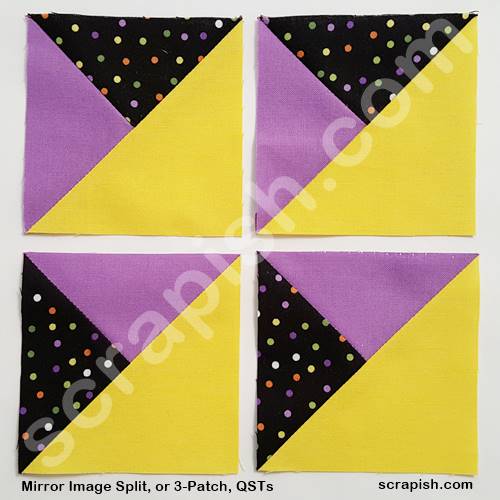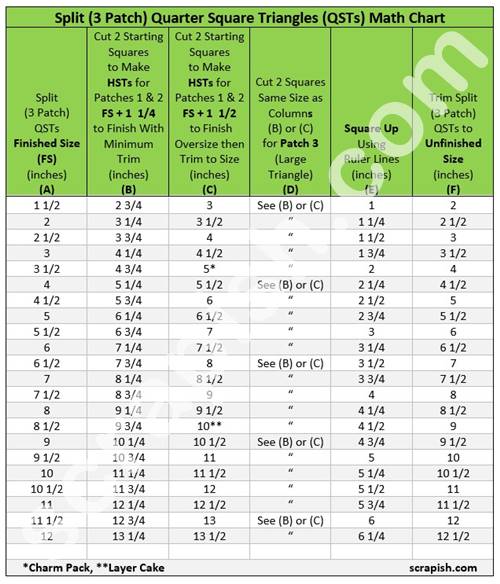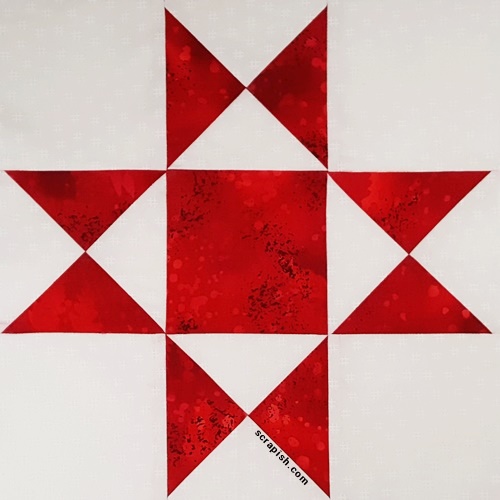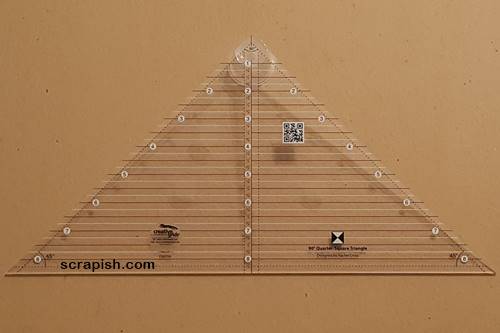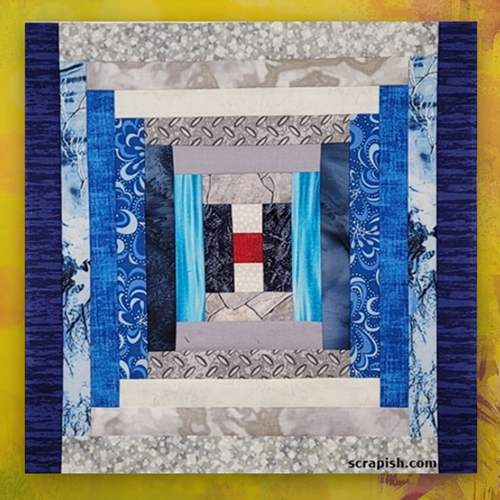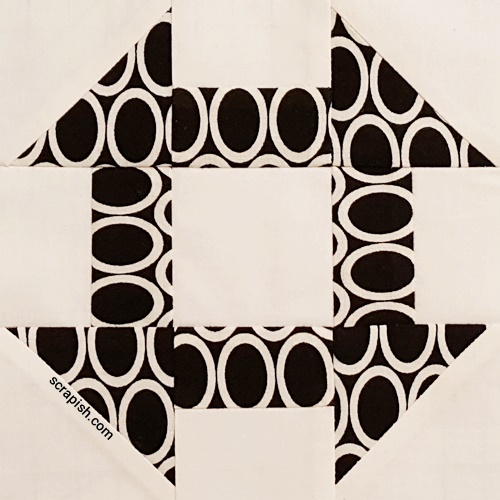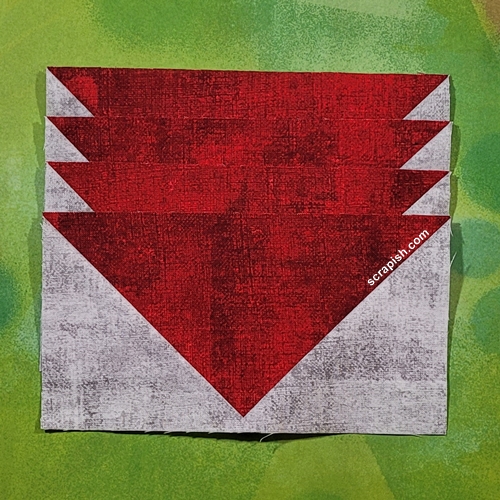Subscribe to the Quilt Blocks Digest newsletter for updates, special offers & exclusive content!
- Home
- How to Quilt
- Split Quarter Square Triangles
Split Quarter Square Triangles Tutorial
Split, three patch, or mirror image quarter square triangles (QSTs) are used in a lot of quilt blocks, especially star blocks. See step-by-step how easy it is to make them!
In Lesson 1 we learned to make QSTs as hourglass quilt blocks. We used two different contrasting fabrics to first make two half square triangles and then we made our QSTs. We also found out what our QSTs would look like if our two half square triangles were made using four different fabrics.
Lesson 2: Split QSTs
Here, in Lesson 2 we will learn how to make split QSTs.
We will use fabrics in three different colors: a two-color half square triangle and a one-color plain square.
This results in a square that has three different triangles called split quarter square triangles (or three patch QSTs), or mirror image QSTs.
Triangles 1 and 2 will be small and the same size. Triangle 3 will be twice their size.
Yield
How may QSTs can you make from each half square triangle? Two.
- 1 half square triangle = 2 half quarter square triangles
Quarter Square Triangles Math
The math for a QST is to add 1 1/4 inches to the finished size of the QST unit. Make the unit and then trim up the edges, cutting off the dog ears.
The math is the same for QSTs as hourglass blocks or split QSTs (also called three patch QSTs).
Quarter Square Triangle Size =
Unit Finished Size + 1 1/4 inches
Adding 1 1/4 inches results in very little fabric waste. However, your stitching needs to be a very accurate 1/4 inch seam, which leaves little room for error.
Beginners may want to add 1 1/2 inches instead. Then, trim the excess fabric.
Quarter Square Triangles Math Chart
Here's a chart that includes common sizes for QSTs. The math has been done for you!
Here's how to read the above chart:
- Locate the Finished Size (A) of the QSTs you want to make.
- Cut 2 squares either 1 1/4 (B) or 1 1/2 (C) inches larger than that in Fabrics A and B to make HSTs.
- From Fabric C, cut 2 squares (D) the same size as those used to make the HSTs. These will be cut in half diagonally from corner to corner to make 4 large triangles.
- Trim the split QSTs using the corresponding Ruler Lines (E) to square them to their Unfinished Size (F).
Quarter Square Triangles Tutorial
- All seams are 1/4 inch unless otherwise noted.
- Fabric A (print)
- Fabric B (purple solid)
- Fabric C (yellow solid)
Step 1 Cut Squares and Make HSTs First, use the math chart above to locate the finished size of your QSTs (Column A).
From Fabric A cut 1 square and from Fabric B cut 1 square in the size noted in Column B (1 1/4 inch larger than finished size) or Column C (1 1/2 inch larger than finished size).
Next, from Fabric C cut 2 more squares the same size (Column D).
Make your half square triangles (HSTs) using one square each of Fabrics A and B. (Step by step photos are shown in Lesson 1 - Hourglass Blocks.)
(1a) Place one Fabric A square right side up and place one Fabric B square right side down on top of it. Use a pencil to draw a diagonal line from one corner to corner on the wrong side of the Fabric B square.
(1b) Stitch a 1/4 inch seam away from both sides of the marked line.
(1c) Using a rotary cutter, cut the squares apart on the marked diagonal line, making 2 HSTs.
(1d) Open the 2 HSTs with fabrics right side up and press the seams toward the darker fabric.
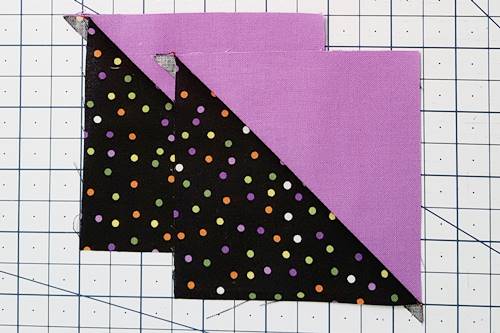
Step 2 Start with one half square triangle and one square.
(Yes, the square is a little bigger than the half square triangle because we started with 3 squares all cut the same size.)
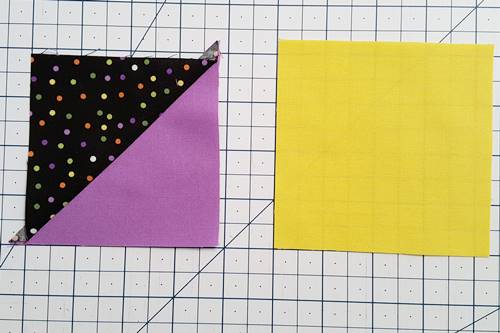
Step 3 Using a rotary cutter, cut the half square triangle in half diagonally from one corner to the other. You have now cut the half square triangle into two halves of a QST.
Using a rotary cutter, cut the plain square in half diagonally from one corner to the other. The square is now two half square triangles.
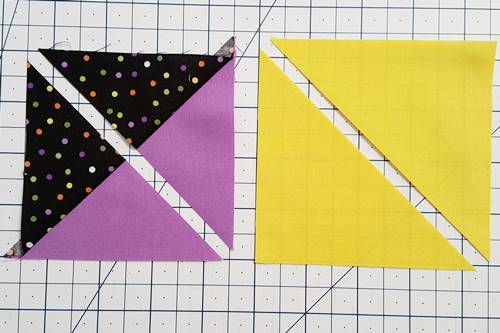
Step 4 With right sides together, pair one of the QST halves with one of the half square triangle halves. Align them along their long edges. Stitch a 1/4 inch seam.
You have now made a split or three patch quarter square triangle.
Repeat for remaining units.
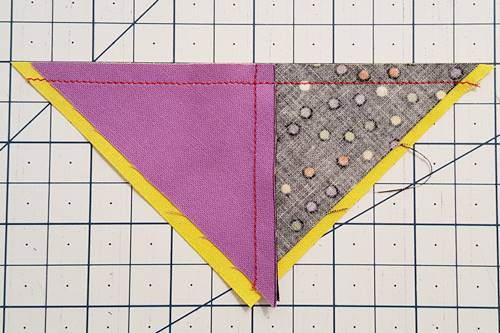
Step 5 Open split QSTs with fabrics right side up and press the seam toward the darker fabric.
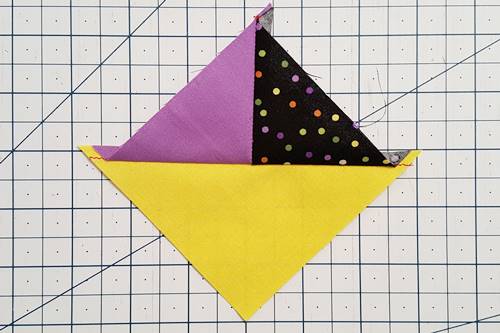
How To Square Up Split Quarter Square Triangles
Step 6 Square up split or three patch QSTs from the center of the block where the two small triangles meet.
Divide the unfinished unit size in half (Column E in math chart above).
In this case, I'm making a 3 1/2 inch finished unit. Half of that is 1 3/4 inches.
So, on my quilting ruler I found the vertical and horizontal lines that correspond to this measurement (1 3/4 inches) and align them with the center of the block where the two small triangles meet (see where the drawn blue lines meet).
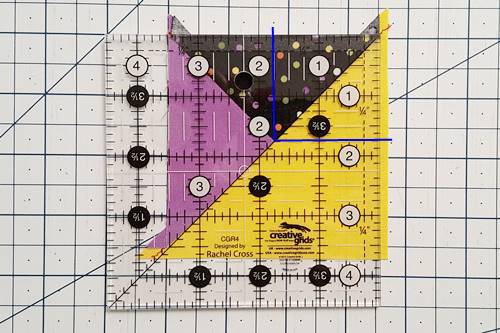
Step 7 Using a rotary cutter, trim the unit along the right and top edges.
Rotate the unit 180 degrees and now you can align the bottom and left edges along the measurement lines that correspond to your unfinished unit size (Column F in math chart above). Here, that's 3 1/2 inches.
The center of your split or three patch QST should align with the measurement lines that are half of its unfinished size. (In this case, that's 1 3/4 inches.)
Be sure your unit is centered before trimming. Align the center of the unit (where the 2 small triangles meet) with the measurement lines that are half its unfinished size (here, the 1 3/4 inch measurement lines).
Use a rotary cutter to trim the unit along the right and top edges and your split or three patch QSTs are squared up!
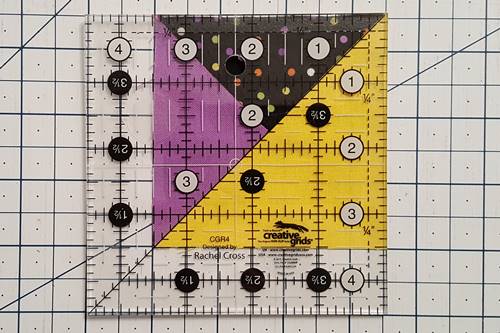
Step 8 Trim any remaining split QSTs.
Mirror Image QSTs
What we end up with are mirror image QSTs. Look carefully, the units are not exactly the same.
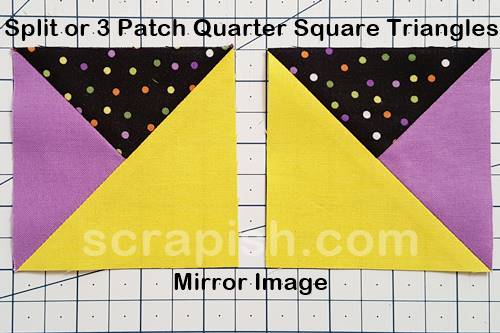
Here's a better view. Look at the top row. See the yellow triangles? Now look at where the purple triangles are in relation to them.
Take a look at the bottom row. Spot the yellow triangles. Now take a look at where the polkadot triangles are in relation to the yellow triangles.
The units are not the exactly same, they are mirror images of one another.
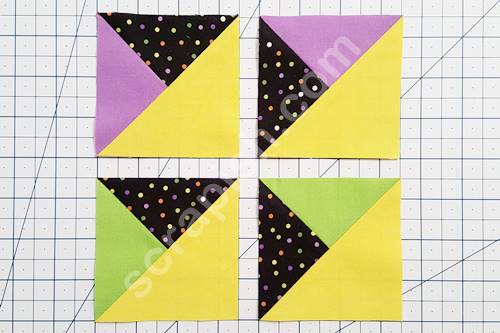 two sets of mirror image quarter square triangles.
two sets of mirror image quarter square triangles.What if you want your QSTs to be exactly the same?
Let me show you in Lesson 3: Non-Mirror Image 3 Patch Quarter Square Triangles.
Subscribe to the Quilt Blocks Digest newsletter for updates, special offers & exclusive content!
You will receive an email asking you to confirm your consent to subscribe. You must click on the confirmation link contained in that email in order to be subscribed and receive emails.
Your email address is never shared. Unsubscribe any time.
